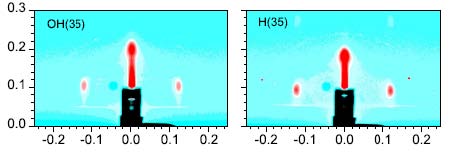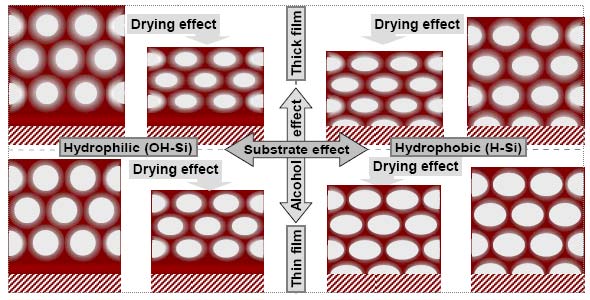Surfactant-mediated growth of mesoporous and nanostructured films
Nanostructured materials, having unique physical, chemical and biological properties, are becoming a subject of multidisciplinary research area. Such properties of the nanostructured materials mainly arising from collective behavior of low-dimensional objects (nanoobjects) in a matrix and essentially depend on the size, shape and arrangement of the nanoobjects in the matrix. It is thus crucial to control these parameters to get desire structure and properties. Different synthesis and processing techniques have been developed in this direction, among which, surfactant-mediated growth of nanostructured materials is now becoming a quite useful technique. Surfactants, which are known to form micelles (or reverse micelles) of uniform size, shape and organization, can be effectively used to form surfactant-inorganic mesostructures by organizing micelles in inorganic matrix. Such mesostructure materials can be transformed to mesoporous materials having wide range of applications as low dielectric constant materials, sensors, catalyst, optoelectronic devices, drug delivery, etc. and can be used as template to form metal nanoobjects of desire size and shape. Nanoobjects in inorganic matrices form nanostructured materials. Surfactants can also act as reducing and stabilizing agent, which can help in synthesis of metal nanoparticles. Such nanoparticles can be used to synthesize nanostructured materials.
 Structural evolution of evaporation-induced self-assembled CTAB-silica mesostructured films on differently-treated Si substrates were monitored using XR and GISAXS techniques. Centered rectangular (c2mm space group) structure is observed in dried films on both the substrates showing clear deviation from perfect 2D-hexagonal (p6m) structure. Such deviation is directly related to the change in shape of the micelles in the film. With time the silica materials try to squeeze due to drying. However, squeezing is not allowed along in-plane direction due to the attachment of the film on the substrate. Such asymmetric squeezing compressed the structure and also developed stress. The latter deteriorates the ordering of the film. The compression depends on the silica wall thickness; more the thickness more is the compression. The silica wall thickness again depends on the amount of excess alcohol. More we add the excess alcohol, less is the film thickness and the silica coating layer thickness, hence the compression and stress, which are clearly observed in the structure of the film. Excess alcohol not only act as cosolvent as mentioned before, but also act as cosurfactant.
Structural evolution of evaporation-induced self-assembled CTAB-silica mesostructured films on differently-treated Si substrates were monitored using XR and GISAXS techniques. Centered rectangular (c2mm space group) structure is observed in dried films on both the substrates showing clear deviation from perfect 2D-hexagonal (p6m) structure. Such deviation is directly related to the change in shape of the micelles in the film. With time the silica materials try to squeeze due to drying. However, squeezing is not allowed along in-plane direction due to the attachment of the film on the substrate. Such asymmetric squeezing compressed the structure and also developed stress. The latter deteriorates the ordering of the film. The compression depends on the silica wall thickness; more the thickness more is the compression. The silica wall thickness again depends on the amount of excess alcohol. More we add the excess alcohol, less is the film thickness and the silica coating layer thickness, hence the compression and stress, which are clearly observed in the structure of the film. Excess alcohol not only act as cosolvent as mentioned before, but also act as cosurfactant.  Analysis of the XR data measured in different time interval and the GISAXS data measured for the dried film suggest that during deposition, cylindrical shaped micelles are circular on OH-Si to from perfect 2D-hexagonal structure, while elliptical on H-Si to from compressed 2D-hexagonal structure. Analysis of the XR data measured in different time interval and the GISAXS data measured for the dried film suggest that during deposition, cylindrical shaped micelles are circular on OH-Si to from perfect 2D-hexagonal structure, while elliptical on H-Si to from compressed 2D-hexagonal structure. Such difference in shape is related to different attachment of the film with the substrate, namely silica on hydrophilic OH-Si substrate and hemicylindrical micelles on hydrophobic H-Si substrate. For the dried films, the maximum and minimum deformed structures are observed for the thick film on OH-Si and for the thin film on H-Si, respectively. Such difference in shape is related to different attachment of the film with the substrate, namely silica on hydrophilic OH-Si substrate and hemicylindrical micelles on hydrophobic H-Si substrate. For the dried films, the maximum and minimum deformed structures are observed for the thick film on OH-Si and for the thin film on H-Si, respectively.  However, considering the shape of the micelles itself, the maximum and minimum deformed shapes are predicted for the thick film on H-Si and for the thin film on OH-Si, respectively. Combining initial shape and the effect of compression with time, which are related to the nature of substrate and the amount of excess alcohol, respectively, final structures of the dried films along with the shape of the micelles are formed, which are of immense importance for their proper use as template and other application [published in Soft Matter 8, 2956 (2012)]. However, considering the shape of the micelles itself, the maximum and minimum deformed shapes are predicted for the thick film on H-Si and for the thin film on OH-Si, respectively. Combining initial shape and the effect of compression with time, which are related to the nature of substrate and the amount of excess alcohol, respectively, final structures of the dried films along with the shape of the micelles are formed, which are of immense importance for their proper use as template and other application [published in Soft Matter 8, 2956 (2012)].
|

